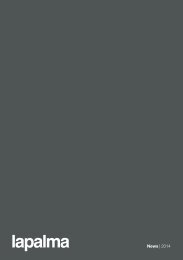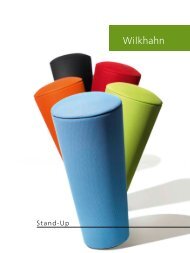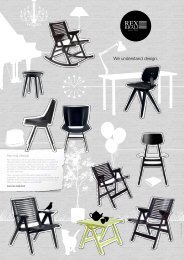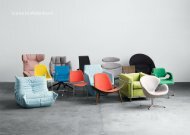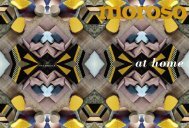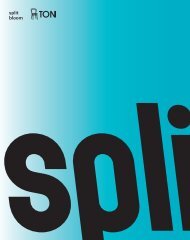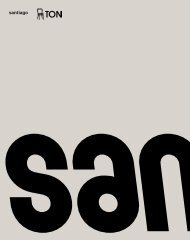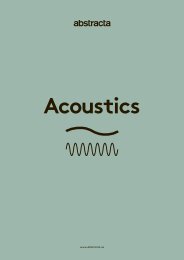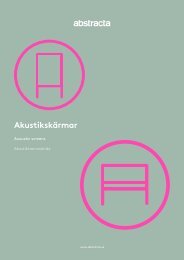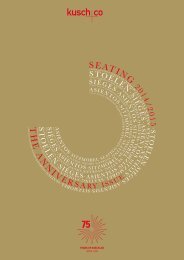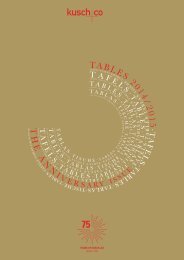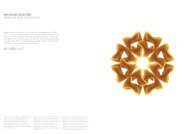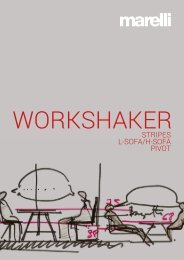Artemide Leuchtenkonzept
Von Deckenleuchten bis hin zu Tischleuchten
Von Deckenleuchten bis hin zu Tischleuchten
Create successful ePaper yourself
Turn your PDF publications into a flip-book with our unique Google optimized e-Paper software.
Issey Miyake<br />
After studying graphic design at<br />
the Tama Art University in Tokyo<br />
(1964), Issey Miyake (born in<br />
Hiroshima in 1938) moved to Paris<br />
(1966-68), where he worked as an<br />
apprentice with G. Laroche and<br />
H. de Givenchy. In 1971 he set up<br />
his own fashion house and<br />
presented the first collection<br />
under his name in New York.<br />
Since the early seventies, Miyake<br />
has been carrying out research<br />
into materials and design<br />
techniques at his Tokyo studio.<br />
Out of this came his rigid plastic<br />
bustiers, gowns made of oilcloth<br />
and later, in the early nineties, his<br />
celebrated pleated garments.<br />
In Paris the Fondation Cartier staged<br />
a retrospective of his work entitled<br />
Issey Miyake Making Things<br />
(1999). In his creations traditional<br />
Oriental elements are fused with<br />
technologies and high-tech materials<br />
typical<br />
of the West.<br />
<strong>Artemide</strong>’s IN-EI ISSEY MIYAKE is<br />
a collection of suspended, table and<br />
floor lamps; the shadows cast by the<br />
lamps are combined with subtle,<br />
beautiful nuances of light. The unique<br />
folds creating the shapes<br />
and the durability of the shades<br />
are the result of an innovative<br />
technology developed by Issey Miyake.<br />
Thanks to a recycled material<br />
featuring a higher transparency to<br />
light than paper, the plasticity of the<br />
lampshades is perfectly achieved<br />
without need for internal structures:<br />
the process of folding actually creates<br />
volumes which are solid enough<br />
to be easily remodelled. When not<br />
in use, the lamps can be folded and<br />
stored. “I’m particularly proud<br />
of this collaboration,” says Ernesto<br />
Gismondi. “Issey Miyake devotes<br />
his exceptional artistic talents to a<br />
research focused on the needs and<br />
lives of the individuals: the same<br />
commitment can be seen in The<br />
Human Light, <strong>Artemide</strong>’s leading<br />
philosophy. So our values and vision<br />
were in tune with Issey Miyake<br />
from the very beginning.” IN-EI it<br />
means “shadow, shading, nuance”<br />
in Japanese; the project started in<br />
2010 at the Miyake Design Studio<br />
when Jun Mitani created a new<br />
process using a computer software<br />
based on 3D geometric formulae.<br />
“132 5. ISSEY MIYAKE” is a clever<br />
method of creating clothing and<br />
represents an successful example<br />
of what can be achieved through<br />
thorough research into textiles and<br />
technology. The IN-EI project uses<br />
a special fabric that can be folded<br />
to create and retain three-dimensional<br />
shapes. IN-EI ISSEY MIYAKE<br />
was created through the partnership<br />
between <strong>Artemide</strong> lighting knowhow<br />
and Reality Lab innovative approach<br />
to materials and design.<br />
IN-EI ISSEY MIYAKE réalisée par<br />
<strong>Artemide</strong> est une collection de<br />
suspensions, lampes de table et<br />
lampadaire ; les ombres créées par<br />
les lampes sont parcourues par<br />
des subtiles et très belles nuances<br />
lumineuses. Les plis inimitables qui<br />
déterminent les formes plastiques<br />
et la solidité des lampes sont réalisés<br />
avec une technologie originale créée<br />
par Issey Miyake. Grâce au matériel<br />
recyclé, d’une transparence<br />
lumineuse supérieure à celle du<br />
papier, les lampes gardent une<br />
forme parfaite sans avoir besoin<br />
d’une structure interne : le processus<br />
de pliage, en effet, crée des volumes<br />
suffisamment solides qui peuvent<br />
être modelés sans aucun problème.<br />
Quand elles ne sont pas utilisées les<br />
lampes peuvent être repliées et ainsi<br />
conservées. « Je suis particulièrement<br />
fier de cette collaboration », affirme<br />
Ernesto Gismondi, « Issey Miyake<br />
consacre son exceptionnel engagement<br />
artistique à une recherche<br />
attentive aux exigences de l’Homme<br />
et de sa vie : le même engagement<br />
est reconnaissable dans The Human<br />
Light, la philosophie qui guide la<br />
mission d’<strong>Artemide</strong>. Avec Miyake<br />
il a été question donc tout d’abord<br />
d’un partage de valeurs et de vision<br />
».IN-EI en japonais signifie « ombre,<br />
obscurité, nuance » et la recherche a<br />
débuté en 2010 au Miyake Design<br />
Studio pendant qu’un nouveau<br />
processus a été développé par Jun<br />
Mitani en utilisant un programme<br />
mathématique avec des formules<br />
géométriques tridimensionnelles.<br />
« 132 5. ISSEY MIYAKE » est une<br />
méthode révolutionnaire pour<br />
créer des vêtements et constitue<br />
un exemple de ce que l’on arrive<br />
à réaliser à travers la recherche<br />
sur les textiles et les technologies.<br />
Le projet en effet se base sur un tissu<br />
spécial capable de structurer et<br />
garder des formes en 3D tout en<br />
partant d’un seul morceau de tissu.<br />
IN-EI ISSEY MIYAKE est né de la<br />
rencontre entre les compétences<br />
d’<strong>Artemide</strong> dans le secteur de<br />
l’éclairage et l’approche innovatrice<br />
du Reality Lab concernant les<br />
matériaux et le design.<br />
Die <strong>Artemide</strong>-Kollektion IN-EI IS-<br />
SEY MIYAKE besteht aus Pendel-,<br />
Tisch- und Stehleuchten. Die von<br />
den Leuchten erzeugten Schatten,<br />
werden von zarten, wunderschönen<br />
Lichtnuancen durchzogen.<br />
Die unnachahmlichen Falten, die<br />
die plastische Form und Stabilität<br />
der Leuchten bestimmen, werden<br />
mit einer eigens von Isssey Miyake<br />
entwickelten Technik hergestellt.<br />
Durch das recycelte PET-Material,<br />
das eine höhere Lichtdurchlässigkeit<br />
als Papier aufweist, behalten die<br />
Leuchten auch ohne Innenrahmen<br />
exakt ihre Form. Das Falten des<br />
Materials führt nämlich zu stabilen<br />
Konstruktionen, die problemlos<br />
wieder neu geformt werden<br />
können. Wenn die Leuchten nicht<br />
eingesetzt werden, können sie<br />
flach zusammengefaltet aufbewahrt<br />
werden. „Ich bin auf diese<br />
Zusammenarbeit besonders stolz“,<br />
bestätigt Ernesto Gismondi.<br />
„Issey Miyake stellt sein außerordentliches<br />
künstlerisches Engagement<br />
in den Dienst der sorgfältigen<br />
Erforschung der Bedürfnisse des<br />
Menschen und seines Lebens.<br />
Dasselbe Engagement liegt auch<br />
der Philosophie The Human Light<br />
zugrunde, zu der <strong>Artemide</strong> sich<br />
verpflichtet hat. Mit Miyake gab<br />
es vor allem in den Werten und der<br />
Sichtweise eine große Übereinstimmung.“<br />
Das japanische „IN-EI“<br />
heißt so viel wie „Schatten,<br />
Schattenreichtum, Schattierung“;<br />
das Forschungsprojekt begann 2010<br />
im Miyake Design Studio, als Jun<br />
Mitani auf der Grundlage eines<br />
Mathematikprogramms mit dreidimensionalen<br />
geometrischen Formeln<br />
ein neues Verfahren entwarf.<br />
„132 5. ISSEY MIYAKE“ beschreibt<br />
eine geniale Methode zur Herstellung<br />
von Kleidungsstücken und ist<br />
ein Beispiel dafür, was Forschung bei<br />
Textilmaterialien und in der Technologie<br />
leisten kann. Und in der Tat<br />
bedient sich dieses Projekt einer<br />
speziellen Faser, die - ausgehend von<br />
einem einzigen Stück Stoff - in der<br />
Lage ist, dreidimensionale Formen<br />
zu bewahren. IN-EI ISSEY MIYAKE<br />
ist aus dem Zusammenspiel der<br />
Lichtkompetenz von <strong>Artemide</strong> und<br />
dem innovativen Ansatz von Reality<br />
Lab gegenüber Materialien und<br />
Design entstanden.<br />
IN-EI ISSEY MIYAKE realizada por<br />
<strong>Artemide</strong> es una colección de<br />
lámparas de suspensión, sobremesa<br />
y de pie; las sombras creadas por las<br />
lámparas se manifiestan a través de<br />
manchas sutiles y bellas de la luz.<br />
Gracias al material reciclado, desde<br />
la transparencia luminosa superior a<br />
la del tejido, las lámparas mantiene<br />
perfectamente su forma sin necesitar<br />
estructuras internas: el proceso de<br />
plegado, de hecho, crea volúmenes<br />
suficientemente sólidos, que pueden<br />
ser remodelados sin problemas.<br />
Cuando las lámparas no se utilizan<br />
se pueden conservar plegadas.<br />
“Estoy particularmente orgulloso<br />
de esta colaboración” afirma Ernesto<br />
Gismondi; “Issey Miyake dedica<br />
su propio tiempo de creación a una<br />
búsqueda que se fija en las exigencias<br />
del hombre y de su vida; el mismo<br />
empeño se reconoce en The Human<br />
Light, al filosofía que guía la misión<br />
<strong>Artemide</strong>. Con Miyake se ha tratado<br />
sobre todo de una sintonía de valores<br />
y visión”. IN-EI en japonés significa<br />
“sombra, sombreado, matices” y la<br />
búsqueda empieza en el 2010 en el<br />
Estudio Miyake Design cuando un<br />
nuevo proceso se desarrolla por Jun<br />
Mitani usando un programa matemático<br />
con fórmulas geometrías<br />
tridimensionales. “132 4. ISSEY MI-<br />
YAKE” es un método genial para<br />
cera ropa y constituye un ejemplo<br />
de y constituye un ejemplo de lo que<br />
puede lograrse a través de la investigación<br />
de los textiles y las tecnologías.<br />
De hecho, el proyecto IN -EI hace<br />
uso de un tejido especial que se puede<br />
plegar para asumir y mantener<br />
las formas tridimensionales. IN -EI<br />
ISSEY MIYAKE nació del encuentro<br />
entre la experiencia de <strong>Artemide</strong> en<br />
el ámbito de la iluminación y el<br />
enfoque innovador adoptado por<br />
el Laboratorio de Realidad hacia<br />
los materiales y el diseño.<br />
41



